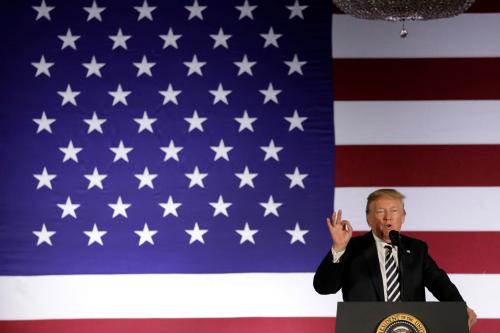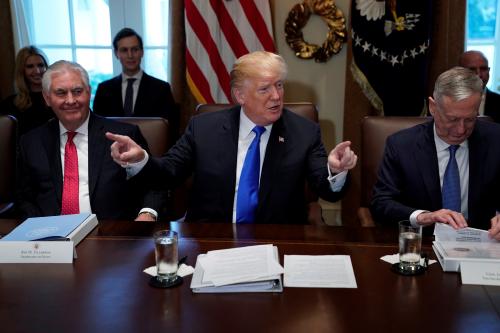The United States has been shaken to its core.
For two months, through three recounts and dozens of court cases challenging the outcome of the 2020 election in six states, President Trump has insisted against all evidence that he won the election. And then, on Wednesday, the last straw. He incited a mob to violence against a duly elected, co-equal branch of government. Most of America is outraged and wondering what, if anything, can be done immediately to stop a man who cares only for himself and has no limits from committing further assaults on law and the Constitution.
There are several options, starting with efforts to remove the president from office or strip him of his authority. But for both constitutional and political reasons, any such effort would require substantial support, pre-wired across party lines. Honorable intentions are not enough. Moral indignation must be tempered by political realism. Trying and failing would be worse than doing nothing.
As the chaos unfurled last night many members of Congress called for Trump to be impeached. Today Sen. Chuck Schumer issued a statement urging the administration to take 25th-Amendment action and stating that if none is taken, Congress should reconvene for impeachment proceedings. It could be a simple, one-count indictment: sedition. Here’s the law:
If two or more persons in any State or Territory, or in any place subject to the jurisdiction of the United States, conspire to overthrow, put down, or to destroy by force the Government of the United States, or to levy war against them, or to oppose by force the authority thereof, or by force to prevent, hinder, or delay the execution of any law of the United States, or by force to seize, take, or possess any property of the United States contrary to the authority thereof, they shall each be fined under this title or imprisoned not more than twenty years, or both.
(June 25, 1948, ch. 645, 62 Stat. 808; July 24, 1956, ch. 678, § 1, 70 Stat. 623; Pub. L. 103–322, title XXXIII, § 330016(1)(N), Sept. 13, 1994, 108 Stat. 2148.)
Any effort to impeach and remove President Trump would face two daunting obstacles. The first is time. With just 13 days to go, it may not be possible to complete the required procedures in time even if the House were to impeach swiftly, which it could do with a simple majority.
Second, the Senate would have to muster a two-thirds majority to convict. Despite Majority Leader Mitch McConnell’s strong speech on the Senate floor yesterday and the shrinking number of hard-core Trump supporters in the Republican caucus, conviction would probably be difficult. Would 17 Senate Republicans support it even if McConnell (whose majority leadership is expiring soon) green-lights the effort?
Another option: invoke the 25th Amendment. As we’ve written before, the 25th Amendment is one way to replace a president who is unable to discharge his duties. Section 4 reads:
“Whenever the Vice President and a majority of either the principal officers of the executive departments or of such other body as Congress may by law provide, transmit to the President pro tempore of the Senate and the Speaker of the House of Representatives their written declaration that the President is unable to discharge the powers and duties of his office, the Vice President shall immediately assume the powers and duties of the office as Acting President.”
In the past the provisions have only been invoked voluntarily and when the president was going in for surgery and would thus be under anesthesia. Invoking the 25th would test the amendment since Trump is in good health—but perhaps unable to “discharge the powers and duties of his office” for psychological reasons. In any event, the 25th Amendment does not define “inability,” leaving it to the vice president and other members of the administration to make this determination.
Invoking the 25th Amendment would have one clear advantage over impeachment: because it would come from inside the administration and be led by the vice president, it would be much harder to characterize as a partisan plot against the president. That said, it would face substantial legal and political obstacles.
The letter from the vice president and a majority of leaders of executive departments would trigger a complex process. If President Trump sends a written declaration to the House and Senate asserting his fitness to continue in office, Congress would be required to assemble within 48 hours to consider the issue. A two-thirds vote of both the House and the Senate would be needed to sustain the claim that the president is unfit to serve.
For the 25th Amendment to go into effect, then, the effort would need the support of at least 17 Republican senators and roughly 70 Republican House members. All but 7 Republican senators voted against the objections to Arizona and Pennsylvania slates of electors, leaving a pool of more than 40 who may be open to invoking the 25th Amendment.
The House would be a closer call. Only 83 Republicans opposed the objection to the Arizona slate, and only 66 opposed the Pennsylvania objection. Based on their votes yesterday, the top two House Republicans, Minority Leader Kevin McCarthy and Minority Whip Steve Scalise, would almost certainly be opposed to invoking the 25th Amendment. Would Liz Cheney, the third-ranking House Republican, take the lead in rallying the Republican minority to the cause? Speaking on Fox News she did not mince words: “There is no question that the president formed the mob, the president incited the mob, the president addressed the mob. He lit the flame.”
The options explored above are dramatic and would no doubt be enthusiastically embraced by those who have long feared Trump’s anti-democratic tendencies. But they are also difficult to enact even with a Republican Party that has finally fractured over Trump’s behavior. Are there other ways to go?
As a first step, members of the White House staff should resign immediately, as a group, leaving only a small band of loyalists in the presidential bunker. Republican congressional colleagues of former Rep. Mark Meadows, now serving as the president’s chief of staff, should journey up Pennsylvania Avenue to urge him or—failing that—shame him into tendering his resignation.
Many people fear that an increasingly bunkered and desperate president could seek to use the U.S. military to maintain his power. Recently all ten living previous Secretaries of Defense penned a strong op-ed in the Washington Post reminding the military of their duty to uphold the law and Pentagon leaders have let it be known that they will resign before carrying out an unlawful order. To bolster these efforts, Congress could also pass an amendment to the Defense Authorization Act prohibiting the use of any appropriated funds for purposes whose legality military leaders have questioned, pending a judicial resolution of the controversy.
Every other confirmed or acting department head—especially those who oversee departments with law enforcement capacity—should make a similar statement pledging not to obey illegal orders.
The final option, of course, is to do nothing but remain vigilant and hope that in the next 13 days, President Trump does nothing more to disrupt the peaceful transfer of power. The final tableau of this presidency will take place on Inauguration Day itself. Whether or not Trump will attend is still unknown. Nonetheless, it is imperative that as many former presidents as possible—especially George W. Bush, the only living Republican ex-president—attend the inauguration to symbolize the unbroken continuity of our constitutional traditions.
The Brookings Institution is committed to quality, independence, and impact.
We are supported by a diverse array of funders. In line with our values and policies, each Brookings publication represents the sole views of its author(s).









Commentary
What can be done to control Trump in his final days?
January 7, 2021